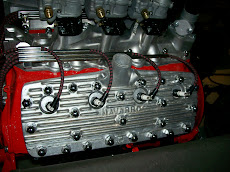In 1932 Henry Ford introduced the Ford flathead V8 engine. In doing so, he created an icon in the automotive world. At that time, a powerful V8 engine in a low price car was unheard of. Although the V8 design had been invented many years before, Ford perfected it to the point where it could be mass produced and inexpensive.
This design gained increased popularity with hot rodders especially in Southern California who were seeking the thrill a fast running car they could take out to the dry lakes at El Mirage or to the salt flats at Bonneville Utah.
Soon companies like Edelbrock, Offenhauser, Weiand, Evans, Edmunds and many others were making speed parts specifically designed for the flathead to increase the horsepower. Aluminum heads and intake manifolds were swapped in place of the stock cast iron pieces to lighten the engine and increase cooling capacity as well as adding horsepower.
Dual, triple and quadruple carburator manifolds offered the hot rodder a simple way to increase horsepower by bolting on extra carburators for extra speed. Headers built by companies like Fenton let the exhaust gases escape quicker than the stock units.
Companies like Potvin and Iskenderian began producing hot rod camshafts with different sized cam lobes that increased horsepower by opening and closing the valves at different times than stock by allowing the gas/fuel mixture to be let into the engine quicker and letting the exhaust gases out quicker for better performance on the dry lakes.
These hot rod engines were put into modified Ford vehicles like Model T, Model A and '32 Ford roadsters. Famous hot rods like the Doane Spencer roadster, the Dick Flint roadster and the Bill NieKamp roadster all ran hot rod flatheads.
skip to main |
skip to sidebar

Flathead Engine
Flathead Engine
Flathead Engine

No comments:
Post a Comment